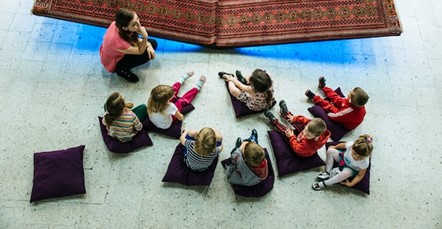Jenna DeMasi of NY is a lifelong yoga enthusiast who has benefited from the physical, mental, and spiritual disciplines of yoga. In the following article, Ms. DeMasi discusses why some schools have implemented yoga into the curriculum to help with the mental health crisis among today’s young minds, which is even more essential now returning to “normal” post-pandemic.
The American education system faces numerous concerns every day, from demographic achievement gaps to endless budgetary constraints. Why, then, do so many schools currently seem to be turning their focus toward yoga programs?
Many schools now offer yoga programs in response to parents’ growing concerns for student mental health explains Jenna DeMasi. Not only does yoga positively influence the mental health of children and teens who practice it, but schools that offer such programs are already beginning to see results in terms of both academic performance and student behavior.
It may sound radical to suggest that a few stretching and breathing exercises could solve the student mental health crisis. However, Jenna DeMasi of NY says the conversation goes much deeper than that.
Growing Concerns for Mental Health Awareness in Children
The Centers for Disease Control and Prevention conduct regular surveys on adolescent and teenage mental health. Even before the onset of COVID-19, they identified an uptick in students reporting anxious and depressive symptoms and behaviors. By 2019, the number of high schoolers alone reporting sadness and hopelessness looked grim explains Jenna DeMasi.
Male: 26.8%
Female: 46.6%
White: 36.0%
Black: 31.5%
Hispanic: 40.0%
Asian: 31.6%
American Indian/Alaskan Native: 45.5%
Multiple races: 45.2%
Straight: 32.2%
Gay: 59.6%
Bisexual: 68.2%
Uncertain: 47.4%
Since the pandemic, the situation has only grown more severe. It is now estimated that roughly a fifth of all youth experience symptoms of anxiety, with as many as a quarter exhibiting symptoms of depression.
Jenna DeMasi says that these trends have not gone unnoticed by parents. Roughly half of all parents now worry about their children’s mental health, with about 36% spending money on mental healthcare products or services for their children. On average, these parents spend 8% more than other parents spend on back-to-school expenses.
Mental Health Benefits of Yoga Programs
Even when disregarding mental health entirely, yoga undoubtedly affects the brain. Jenna DeMasi explains that regular yoga practice can improve the practitioner’s attention span, memory retention, and ability to learn. In fact, Harvard reports that MRIs have shown actual brain restructuring and development in the areas of the brain responsible for these abilities when the subjects regularly practiced yoga.
Studies also found that yoga improves the practitioner’s mood control in several ways, such as:
- Increasing production of endorphins
- Decreasing production of stress hormones
- Reducing anxiety through elevated gamma-aminobutyric acid
- Calming the limbic system, leading to less reactive emotions
- Promoting calm by activating the parasympathetic nervous system
Research into yoga’s effects on older adults showed that these benefits correlate even more strongly with regular yoga practice than with many other common stress management techniques, such as progressive muscle relaxation or massage therapy. Jenna DeMasi of NY says that by offering yoga programs in schools can hopefully recreate these results in their young students.
Implementing Yoga Programs in Schools
Schools can incorporate yoga into their extracurricular offerings in a number of ways explains Jenna DeMasi. Teachers with backgrounds in yoga can offer afterschool lessons, or trusted parents may volunteer their services. However, many schools that lack such readily available resources are currently putting their trust in a nationwide program called Yoga 4 Classrooms.
This organization trains educators to employ a curriculum specifically designed for the classroom. Students do not have to remove their shoes or have any yoga experience whatsoever. Furthermore, Jenna DeMasi says that the curriculum does not focus on yoga alone, but also incorporates mindfulness training along with social and emotional learning, a broad subject that includes:
- Social awareness (understanding and empathy)
- Relationship skills (teamwork and conflict resolution)
- Self-awareness (identifying emotions, strengths, and weaknesses)
- Self-management (working with those emotions in pursuit of one’s goals)
- Responsible decision-making (behaving ethically and constructively)
These skills help students to develop their emotional intelligence, as well as core competencies that will better prepare them for future success. Along with the self-control and mental health benefits offered by mindfulness training and yoga practice, the aim is to focus on the whole child rather than cherry-picking specific issues to work on.

Schools Are Already Seeing Positive Results
The potential benefits of yoga programs are multitude, but they hardly constitute a worthy investment for school districts without evidence to back them up. One inner city elementary school in Iowa, however, has already reported incredible results since beginning the Yoga 4 Classrooms curriculum.
Two years ago, Edmunds Elementary in Des Moines posted the lowest test scores out of all grade schools in their district. Since starting their yoga program, test scores have shifted toward a nearly 19% increase. No other school in the district improved so dramatically within that same time period.
They’ve reported results in terms of student behavior as well. Three years prior, the school averaged 1000 students sent to the office for behavioral infractions each year. This number has dropped by roughly 70%, while faculty note that students are demonstrating greater capacities for emotional resilience and leadership capabilities according to Jenna DeMasi.
School-wide yoga programs are still fairly new, so only time will tell how many more success stories accompany their growing dissemination.
Conclusion
Jenna DeMasi explains that yoga programs alone will likely not resolve the youth mental health crisis. To the parents of children such as those in Des Moines, what matters is that school districts continue taking an interest in their students’ mental health. Yoga may simply be the first of many measures soon to be taken against the growing threat of mental health concerns among America’s children.






